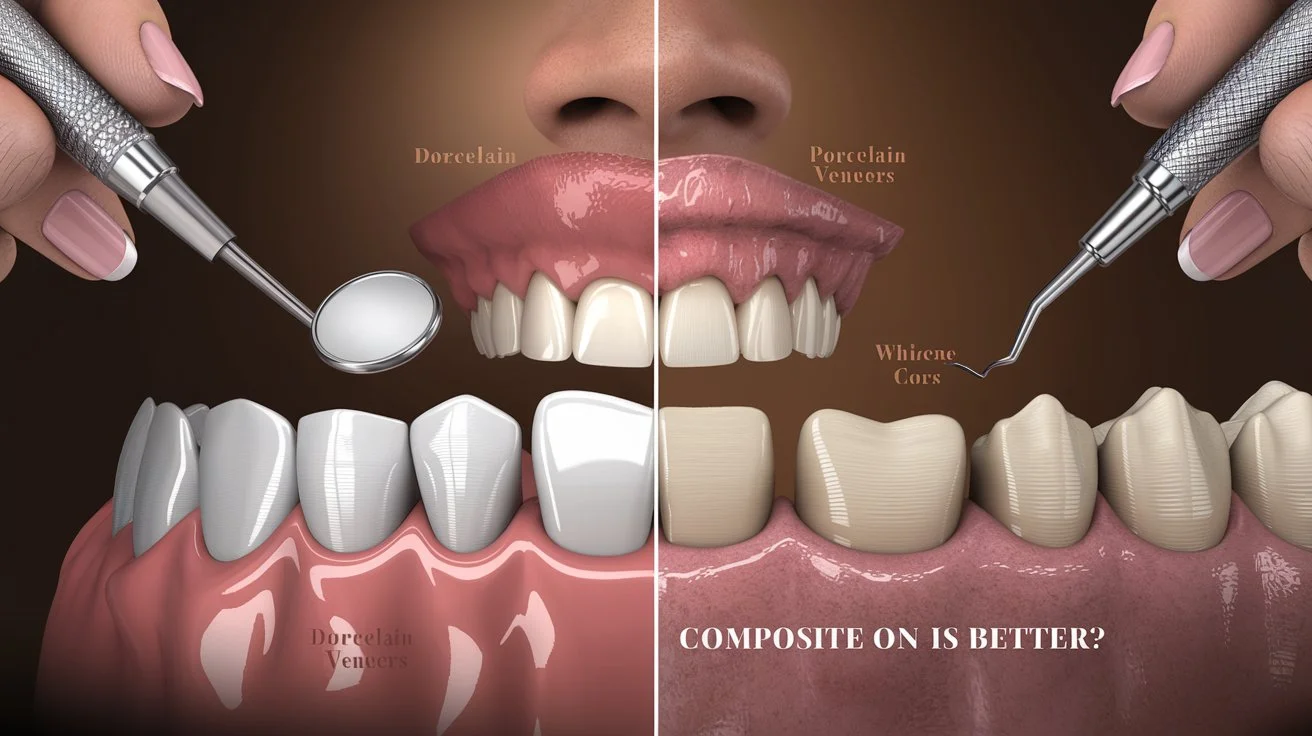Thinking about stepping up your smile game? If you’ve been browsing options to enhance those pearly whites, you’ve probably stumbled upon veneers. But with choices like porcelain and composite veneers on the table, how do you know which one is the best fit for you? Each option has its own set of dazzling benefits, and deciding between them can be a bit like solving a dazzling puzzle. Let’s dive into the world of dental veneers and explore which might be the shining solution for your smile!
Understanding Dental Veneers
Image courtesy: Unsplash
If you’re looking to transform your smile, dental veneers might just be the answer you’ve been searching for. They’re a popular choice for those eager to achieve a radiant, flawless grin. But before jumping into this cosmetic dentistry solution, it’s helpful to understand exactly what dental veneers are.
What Are Dental Veneers?
Dental veneers are thin, custom-made shells designed to cover the front surface of teeth, providing a new layer of beauty. These shells are bonded to the teeth to enhance their color, shape, size, or length. They are custom-crafted to ensure a perfect fit, blending seamlessly with your natural teeth.
Purpose and Benefits of Veneers
Veneers are primarily used for cosmetic purposes, intended to improve the appearance of teeth. Some of the main benefits include:
- – Smile Transformation: Veneers can effectively correct discoloration, close gaps, fix chips, and even alter the size and shape of teeth.
- – Durability: With the right care, veneers can last many years.
- – Stain Resistance: Particularly in the case of porcelain veneers, they resist stains better than natural teeth, keeping your smile whiter for longer.
Overall, veneers offer an aesthetic makeover that can boost confidence and oral appearance dramatically.
Types of Veneers Available
When considering veneers, it’s essential to know there’s more than one type available. The two primary types are porcelain veneers and composite veneers. Each comes with its own set of characteristics, advantages, and considerations, which we’ll explore later in this blog.
Overview of Porcelain Veneers
Porcelain veneers are often considered the gold standard in the world of cosmetic dentistry. Their popularity is largely due to their natural appearance and long-lasting nature.
Composition and Application Process
Porcelain veneers are made from high-quality ceramic that mimics the properties of natural teeth. Crafting these veneers is an intricate process. Here’s a brief overview:
- 1. Consultation: Your dentist will assess your teeth and discuss your desired result.
- 2. Impressions: After deciding on the right look, your dentist will take impressions of your teeth.
- 3. Fabrication: These impressions are sent to a dental lab where skilled technicians craft the veneers tailored precisely for your teeth.
- 4. Preparation and Placement: Your dentist will prepare your tooth by removing a thin layer of enamel. Then, the custom-made veneers are bonded using a special adhesive.
Advantages of Porcelain Veneers
There are several reasons why porcelain veneers are favored:
- – Natural Look: They closely resemble the light-reflecting properties of natural teeth.
- – Stain Resistance: They are resistant to coffee, tea, and smoking stains.
- – Longevity: With proper care, they typically last 10-15 years or even longer.
Limitations and Considerations
While porcelain veneers offer numerous advantages, they also come with some considerations:
- – Cost: They are generally more expensive than composite veneers.
- – Irreversible Process: Enamel removal is part of the preparation, which means there’s no going back to your natural tooth once the veneer is placed.
- – Repair: If a veneer chips or cracks, it can be challenging to repair and may need replacement.
Ultimately, whether you opt for porcelain or composite veneers, the choice should align with your lifestyle, budget, and personal preferences. We’ll dive into composite veneers in the next section to help you make a well-informed decision. Stay tuned!
Overview of Composite Veneers
When it comes to enhancing your smile, composite veneers are a popular choice among many people. These dental heroes are crafted from a tooth-colored resin, offering a quicker and more affordable alternative to other veneer options. Let’s dive a little deeper into what makes composite veneers tick.
Material and Procedure
Composite veneers are made from a composite resin—a versatile and durable material that’s molded directly onto your teeth. The process begins with a dental specialist carefully applying the resin in layers. Each layer is meticulously shaped and polished to match the natural contours of your teeth. An ultraviolet light is then used to harden the resin, ensuring a snug and secure fit. The entire procedure is often completed in just one or two visits, allowing for a swift transformation.
Benefits of Composite Veneers
Opting for composite veneers comes with several appealing benefits:
- – Affordability: They are generally less expensive than porcelain veneers, making them accessible to a wider range of budgets.
- – Quick Application: The procedure is typically faster, as it can often be finalized in a single appointment.
- – Reversibility: Composite veneers can be removed or replaced, offering flexibility if you change your mind in the future.
- – Minor Adjustments: Easily repaired on the spot if damaged or chipped, without the need for a whole new set.
Potential Drawbacks to Consider
While composite veneers are convenient, there are a few downsides to keep in mind:
- – Staining: They are more prone to discoloration over time, especially if you’re a coffee or red wine enthusiast.
- – Durability: They generally don’t last as long as their porcelain counterparts, usually needing replacement every 5 to 7 years.
- – Strength: More susceptible to chips and breakages, particularly for those who grind their teeth.
Comparison: Porcelain Veneers vs Composite Veneers
Image courtesy: Unsplash
Understanding how porcelain and composite veneers stack up against each other can help you make the best choice for your dental makeover.
Durability and Longevity
When it comes to durability, porcelain veneers take the crown. These are crafted from high-quality ceramic materials that are incredibly robust and can last anywhere from 10 to 15 years if properly cared for. Composite veneers, on the flip side, tend to have a shorter lifespan (around 5 to 7 years), as they are less resistant to chipping and wear and tear. If you’re looking for a long-term solution, porcelain might be the winner here.
Aesthetic Appeal and Natural Look
A more natural look might be essential for you, and in this department, porcelain veneers have the edge. They mimic the translucent properties of natural teeth, offering a more lifelike appearance. Composite veneers, while generally effective at enhancing smiles, may not achieve the same level of realism. However, skilled dentists can still create beautifully natural results with composite materials.
Cost Implications and Maintenance
Regarding costs, composite veneers are the budget-friendly champions. They can be significantly less expensive than porcelain veneers, making them a practical option for many. However, keep in mind that because they may require more frequent replacements or repairs, the cumulative costs could add up over the years. For maintenance, both types require diligent oral hygiene practices, but composite veneers may demand extra attention due to their susceptibility to staining.
In summary, choosing between porcelain and composite veneers ultimately depends on your budget, aesthetic preferences, and commitment to maintenance. Each option has unique benefits that can help you achieve the smile of your dreams.
Conclusion
When deciding between porcelain and composite veneers, there’s no one-size-fits-all answer. It ultimately depends on your specific needs, budget, and personal preferences. Here’s a quick recap to guide your choice:
– Porcelain Veneers: These are ideal if you’re looking for a long-lasting, stain-resistant option with a more natural look. They come with a higher price tag but might save time and money in the long run because of their durability.
– Composite Veneers: If you’re seeking a more budget-friendly solution with easier adjustments, composite veneers could be the way to go. They offer a quicker application process and are great for those who want minimal alteration to their natural teeth.
Both options have their merits, so discussing your goals with a qualified dentist can help determine which type best suits your smile. Remember, investing in your smile is always worth it, as it boosts both your confidence and oral health!



